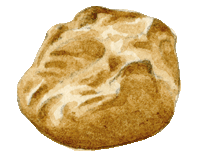Pan de sal or pandesal

Form: Roll
Country of origin: Republic of the Philippines
What distinguishes it from other methods of bread making: Wheat flour is mixed with squash purée
Category of bread: (3) Similar to American rolls, but also resembles crusty rolls found in French restaurants
Particularity: Its origin, like its name, is Spanish, meaning literally “salt bread”
Ingredients: Wheat flour; squash purée; warm water; yeast; lard; oil; sugar; salt

Republic of the Philippines
The tradition is to incorporate pan de sal into the category of what the Americans call “rolls”, a small round bread used to make all sorts of sandwiches. Even so, as its name indicates, pan de sal dates back to before the American presence in the archipelago and the Japanese occupation in 1942. The Philippines, discovered by the Portuguese explorer Ferdinand Magellan, was part of the Spanish colonial empire until the end of the 19th century, so it is only logical to assume that pan de sal is of Spanish origin.
Above all, it is a risen roll made of wheat flour, leaven or yeast, water, and, of course, salt. The Filipino bakers added salt to compensate for the bad quality of flour, and gradually transformed it into what the French call Viennoiserie, in other words, a soft, lightly sugared roll.
What did they add to the original recipe? Oil, sugar, sometimes lard, mixed with flour, and when the result was really a disappointment, squash purée, which gave the pan de sal an unexpected yellow color. So they gave a new incarnation to this roll that had traveled all the way from Spain, which one can now, after so many alterations, compare to American rolls. This just proves that even an imperceptible change in a recipe can end up making you change longitudes before you know it.

